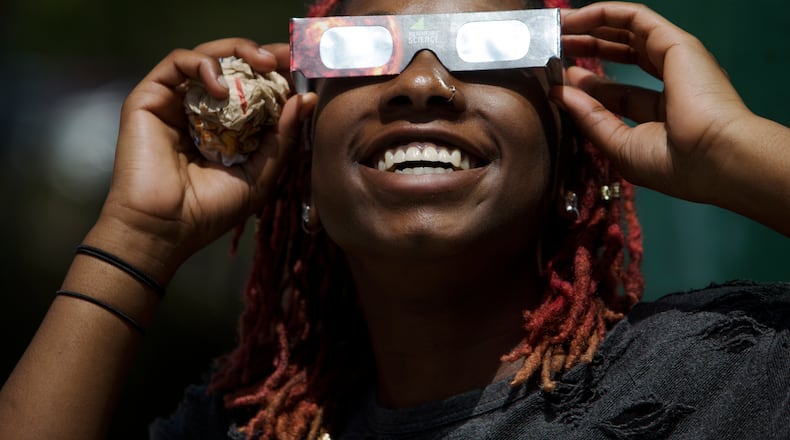Fewer clouds than previously expected will be in the sky during the solar eclipse over metro Atlanta on Monday afternoon.
As of Monday morning, cloud coverage from 2 p.m. to 3 p.m. near the city should be mostly clear. In the northwestern part of the state, however, about 30% to 70% cloud coverage is expected, according to the National Weather Service.
“The farther south you live … the better view you’re gonna have of that eclipse,” Channel 2 Action News meteorologist Brian Monahan said. “(You’ll see) a little less cloud cover as you get in toward Atlanta and the southside.”
The total solar eclipse begins Monday morning over the South Pacific Ocean as the moon passes between the Earth and sun, casting a shadow that will eventually cross over the U.S.-Mexico border at noon and continue over 13 states from Texas to Maine.
In metro Atlanta, the moon’s shadow will arrive around 1:45 p.m., with coverage of the sun peaking at 3:04 p.m. It will all be over by 4:20 p.m. In the city and North Georgia, the peak will result in a partial eclipse that will cover between 82% and 85% of the sun.
The closest location along the path of totality is in Paducah, Kentucky. The small town is just under six hours from Atlanta. However, clouds are expected over much of the path thanks to storms that are moving across the central U.S. So, your best chance for a clear view of totality is in northern New England.
The effects of the eclipse are experienced more intensely the closer you are to the narrow path totality. As peak coverage approaches, daylight dims and is overtaken by an eerie twilight that will make it look like dawn or dusk as streetlights turn on and temperatures drop quickly.
The astronomical event won’t be seen again in the contiguous U.S. for 20 years. The next total solar eclipse will fall on Aug. 23, 2044, according to NASA. However, Alaska will experience totality in 2033.
Otherwise, the next soonest solar eclipse event will happen on Oct. 2 of this year, when a partial eclipse will be visible in the U.S., NASA says. Another partial solar eclipse will be visible on March 29, 2025, and again on Aug. 12 of the same year.
Typically, it takes 400 to 1,000 years before totality returns to the same spot, according to NASA. But one location — Carbondale, Illinois — has fallen in the path of both the 2017 and 2024 solar eclipses.
Speaking of the 2017 eclipse, its path was much narrower than this year’s. That’s because the moon was a little farther away from Earth than it is today, NASA reports. In 2017, the path ranged from about 62 to 71 miles wide compared to 108 and 122 miles now.
The duration of totality will also be longer this year, lasting up to 4½ minutes compared to just under 3 minutes in 2017.
In metro Atlanta, we won’t see the same amount of darkness as locations under 100% totality. It won’t get much darker than standing in a shady spot during the day, according to experts. And while skies should remain clear, there is still a slight chance of showers. However, the probability of seeing rainfall at the time of the eclipse remains minimal, and most showers will stay in northwest Georgia.
But if you do find yourself staring at some clouds — with your eclipse glasses, of course — then there are alternative options. The total solar eclipse can still be viewed online.
NASA will stream telescope views of the sun starting at 1 p.m. The Exploratorium museum will also broadcast eclipse day views starting at 1:45 p.m.
If you’re driving, local law enforcement is urging the use of common sense and not getting behind the wheel with your eclipse glasses on.
“While extremely stylish, they are not regular sunglasses and not meant for looking at anything but partially obstructed balls of 10,000-degree gas approximately 93,000,000 miles away,” Roswell police said. “If you think you can throw them on for a quick glimpse on your commute home, you would be wrong and you will crash.”
Staff writer Caroline Silva contributed to this article.
About the Author
Keep Reading
The Latest
Featured


